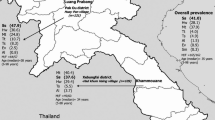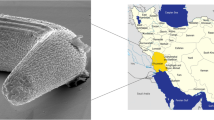Abstract
Strongyloidiasis is one of the neglected tropical diseases caused by infection with the nematode Strongyloides genus and distributed worldwide. Strongyloidiasis can be fatal in immunosuppressed patients induced hyperinfection or disseminated strongyloidiasis. Unfortunately, until now, due to the unspecific clinical symptom in infected individuals and the low sensitivity diagnosis of strongyloidiasis, many patients were misdiagnosed every year. Furthermore, the larvae of the Strongyloides stercoralis (S. stercoralis) is similar to other nematodes such as hookworm, Trichostrongylus increased the difficulty of diagnosis. In this case, the patient is a 63-year-old male person, who had a nearly 30 years medical history of asthma and emphysema, and 4–5-year medical history of diabetes. The sputum examination found some parasite larvae, then we identify the larvae using clinical observation and morphological characteristics combine with examined cytochrome oxidase subunit 1 (COX1) and 18S rRNA genes by PCR, sequence analysis and finally classified by phylogenetic analysis, the larvae were diagnosed as S. stercoralis. Our results showed that diagnosis with strongyloidiasis by morphological characteristics combine with molecular biological methods can improve the sensitive of diagnosis and provide a final diagnosis for the disease in the clinics.




Similar content being viewed by others
References
Beknazarova M, Whiley H, Ross K (2016) Strongyloidiasis: a disease of socioeconomic disadvantage. Int J Environ Res Public Health 13(5):517
Bisoffi Z, Buonfrate D, Montresor A, Requena-Méndez A, Muñoz J, Krolewiecki A, Gotuzzo E, Mena MA, Chiodini PL, Anselmi M, Moreira J, Albonico M (2013) Strongyloides stercoralis: a plea for action. PLoS Negl Trop Dis 7(5):e2214
Buonfrate D, Formenti F, Perandin F, Bisoffi Z (2015) Novel approaches to the diagnosis of Strongyloides stercoralis infection. Clin Microbiol Infect 21(6):543–552
Duvignaud A, Pistone T, Malvy D (2016) Strongyloidiasis in a young French woman raises concern about possible ongoing autochthonous transmission in Spain. Int J Infect Dis 42:43–44
Ericsson CD, Steffen R, Siddiqui AA, Berk SL (2001) Diagnosis of Strongyloides stercoralis infection. Clin Infect Dis 33(7):1040–1047
Greaves D, Coggle S, Pollard C, Aliyu S, Moore E (2013) Strongyloides stercoralis infection. BMJ 347:f4610
Hochberg NS, Moro RN, Sheth AN, Montgomery SP, Steurer F, McAuliffe IT, Wang YF, Armstrong W, Rivera HN, Lennox JL, Franco-Paredes C (2001) High prevalence of persistent parasitic infections in foreign-born, HIV-infected persons in the United States. PLoS Negl Trop Dis 5(4):e1034
Kishimoto K (2008) Endoscopic and histopathological study on the duodenum of Strongyloides stercoralis hyperinfection. World J Gastroenterol 14(11):1768
Knopp S, Mgeni AF, Khamis IS, Steinmann P, Stothard JR, Rollinson D, Marti H, Utzinger J (2008) Diagnosis of soil-transmitted helminths in the era of preventive chemotherapy: effect of multiple stool sampling and use of differenat diagnostic techniques. PLoS Negl Trop Dis 2(11):e331
Krolewiecki AJ, Lammie P, Jacobson J, Gabrielli AF, Levecke B, Socias E, Arias LM, Sosa N, Abraham D, Cimino R, Echazu A, Crudo F, Vercruysse J, Albonico M (2013) A public health response against Strongyloides stercoralis:time to look at soil-transmitted helminthiasis in full. PLoS Negl Trop Dis 7(5):e2165
Mascarello M, Gobbi F, Angheben A, Gobbo M, Gaiera G, Pegoraro M, Lanzafame M, Buonfrate D, Concia E, Bisoffi N (2011) Prevalence of Strongyloides stercoralis infection among HIV-positive immigrants attending two Italian hospitals, from 2000 to 2009. Ann Trop Med Parasitol 105(8):617–623
Meamar AR, Rezaian M, Mohraz M, Hadighi R, Kia EB (2007) Strongyloides stercoralis hyper-infection syndrome in HIV+/AIDS patients in Iran. Parasitol Res 101(3):663–665
Mejia R, Nutman TB (2012) Screening, prevention, and treatment for hyperinfection syndrome and disseminated infections caused by Strongyloides stercoralis. Curr Opin Infect Dis 25(4):458
Requena-Méndez A, Chiodini P, Bisoffi Z, Buonfrate D, Gotuzzo E, Munoz J (2013) The laboratory diagnosis and follow up of strongyloidiasis: a systematic review. PLoS Negl Trop Dis 7(1):e2002
Richter J, Müller-Stöver I, Strothmeyer H, Göbels K, Schmitt M, Häussinger D (2006) Arthritis associated with Strongyloides stercoralis infection in a HLA B-27-positive African. Parasitol Res 99(6):706–707
Rodpai R, Intapan PM, Thanchomnang T, Sanpool O, Janwan P, Laummaunwai P, Wongkham C, Insawang T, Maleewong W (2016) Strongyloides stercoralis diagnostic polypeptides for human strongyloidiasis and their proteomic analysis. Parasitol Research 115(10):4007–4012
Rodrigues RM, de Oliveira MC, Sopelete MC, Silva DAO, Campos DMB, Taketomi EA, Costa-Cruz JM (2007) IgG1, IgG4, and IgE antibody responses in human strongyloidiasis by ELISA using Strongyloides Ratti saline extract as heterologous antigen. Parasitol Research 101(5):1209–1214
Acknowledgments
This work was supported by the National High Technology Research and Development Program of China (No.2015AA020934).
Author information
Authors and Affiliations
Corresponding authors
Ethics declarations
Ethical approval
The study was reviewed by Human Research Ethics Committee of the Sun Yat-sen University in China. Written informed consent was obtained from the patient.
Consent for publication
Written informed consent was obtained from the patients for the publication of this report.
Competing interests
The authors declare that they have no competing interests.
Rights and permissions
About this article
Cite this article
Wang, Lf., Xu, L., Luo, Sq. et al. Diagnosis of Strongyloides stercoralis by morphological characteristics combine with molecular biological methods. Parasitol Res 116, 1159–1163 (2017). https://doi.org/10.1007/s00436-017-5389-y
Received:
Accepted:
Published:
Issue Date:
DOI: https://doi.org/10.1007/s00436-017-5389-y




